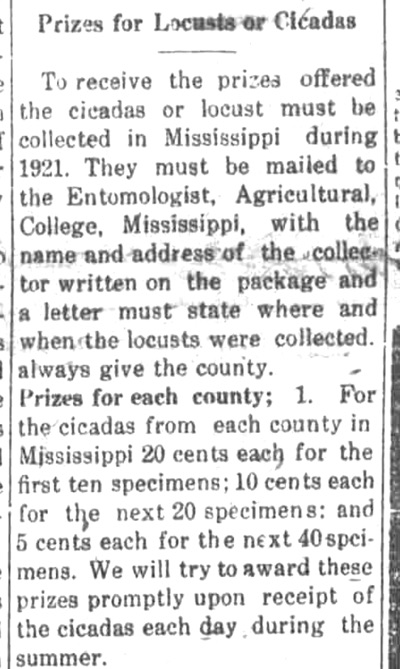Once again I was grinding through the Library of Congress website, and I came across another Cicada story. This story, from the July 21, 1921 edition of the Okolona (Mississippi) Messenger, is a request from the entomologist of the “Agricultural, College, Mississippi” (Agricultural College in Mississippi) for cicadas. Send cicadas to the college and get a prize. Sounds awesome.
The terms cicadas and locusts seem to be used interchangeably, which is common for these old newspaper articles. If you read “locusts” they mean cicadas, in this article at least.
Note that this is from 1921. Don’t send them cicadas today.
Prizes for Locusts or Cicadas
To receive the prizes offer the cicadas or locust must be collected in Mississippi during 1921. They must be mailed to the Entomologist, Agricultural, College, Mississippi, with the name and address of the collector written on the package and a letter must state where and when the locusts were collected. Always give the county.
Prizes for each county 1. For the cicadas from each country in Mississippi 20 cents each for the first ten specimens; 10 cents each for the next 20 specimens; and 5 cents each for the next 40 specimens. We will try to award these prizes promptly upon receipt of the cicadas each day during the summer.
State Prizes; 2. For the largest number of cicadas send in by any one person during the year 1921 $5.00; for the second largest number $3.00; and for the third largest number $2.00. The locusts or cicada should be mailed in as soon as possible after they are collected. Careful record will be kept of all specimens and these prizes will be awarded next fall.
Special Prizes: 3. For a cicada that proves to be a new species, that is not previously know to entomologist, $5.00 for the first specimen; $3.00 for the second and $1.00 each for the next five specimens.
4. For any species of cicada not previously recorded from Mississippi $3.00 for the first specimen; $2.00 for the second, and $1.00 each for the next five specimens.
5. For specimens of the rare small green cicada Okanagana Niridis, $1.00 each for the first ten specimens. The species will most likely be collected in Bolivar, Sunflower, Washington and other Delta Counties during June and July, but may possibly be collected in the other sections of the state during other months.
Okanagana Niridis is actually Okanagana viridis. The meaning of viridis is the color green. Here is a photo.
6. For specimens of Tibicen Linnei $1.00 each for the first ten specimens. This species will most likely be collected in the northern part of the state.
Tibicen Linnei is now known as Neotibicen linnei.
7. For any Periodical Cicada, or 1-year locust collected in Mississippi during 1921, $1.00 each for the first ten specimens. Brood No. 20 of the Periodical Cicada that occurs during May and June of 1921 had been recorded from Georgia, North Carolina, and Virginia, but has never in the past been reported from Mississippi.
This paragraph is the most interesting. They probably mean 1-year stragglers from Brood XIX. (First, I think they mean 13-year or 17-year cicada, not 1-year locust. A 13-Year cicada collected in 1921 would belong to Brood XX (20), which doesn’t exist, and I don’t think it did at the time (I’ll check, may have gone extinct). A 17-year cicada that emerged in 1921 would belong to Brood XII (12) which also does/did not exist. There aren’t any stragglers (4 year) that line up as well. There are four broods that emerge in GA, NC & VA: II which would have emerged in 1928; X which would have emerged in 1919; XIV which would have emerged in 1923; and XIX which would have emerged in 1920 and definitely is also in Mississippi.)
Here’s a chunk of the article:


I’m positive this is the result of communications between Professor R. W. Harned of the Mississippi Agricultural and Mechanical College and William T. Davis.
For anyone not familiar with William T. Davis, he was a self-taught entomologist from New York. His witnessing of Brood II converted him from an accountant to the most prolific describer of North American cicadas. He had people sending him cicadas from all over the country.
In the 1918 (Vol. 26, Iss. 3-4, pp 141-154) Journal of the New York Entomological Society Mr. Davis lists the cicadas of Mississippi using specimens collected by Prof. Harned and his students.
In that paper are three interesting things that happened in relation to this newspaper announcement:
1. N. linnei is listed as being found for the first time in Mississippi but the locale was uncertain due to a mix up with labels.
2. A new subspecies of N. davisi (Tibicen davisi at the time) is described and known today as Neotibicen davisi harnedi. Davis didn’t name a species after himself. N. davisi was named by Smith and Grossbeck in 1907. N. davisi harnedi can often be seen as N. davisi hardeni. It makes sense because the word HARDEN is familiar but the correct name is harnedi; after Professor Harned.
3. Okanagana viridis is described. Imagine you’re in New York receiving cicadas from all over the US. Things are pretty typical regionally but then you get a bright green cicada. It’s generally misplaced for the genus and the coloring is unlike any other Okanagana, which tend to be black with orange, yellow or straw accents. It’s an extremely elusive cicada. Even today only a few institutions have specimens. I wouldn’t be surprised if there were less than 100 specimens in collections.
Davis would have wanted more specimens of these three species (especially O. viridis) along with any distribution data.